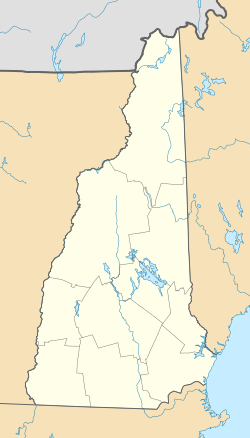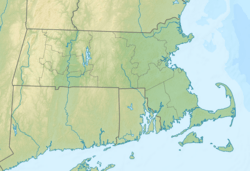Blackwater River (Massachusetts–New Hampshire) facts for kids
Quick facts for kids Blackwater River |
|
|---|---|

The Seabrook Nuclear Power Station, as seen across the Blackwater River in Seabrook
|
|
| Country | United States |
| States | Massachusetts, New Hampshire |
| Counties | Essex County, MA; Rockingham County, NH |
| Towns | Salisbury, MA; Seabrook, NH |
| Physical characteristics | |
| Main source | Salisbury, MA 0 ft (0 m) 42°52′0″N 70°49′22″W / 42.86667°N 70.82278°W |
| River mouth | Hampton Harbor Seabrook, NH 0 ft (0 m) 42°53′20″N 70°49′38″W / 42.88889°N 70.82722°W |
| Length | 3.1 mi (5.0 km) |
The Blackwater River is a small, important waterway that flows through parts of Massachusetts and New Hampshire in the United States. It's about 3.1 miles (5.0 km) long. This river is a special type of waterway called an estuary or tidal inlet. This means it's where fresh water from the land mixes with salty ocean water.
Contents
Where the River Starts and Flows
The Blackwater River begins in a place called a salt marsh in the northeastern part of Salisbury, Massachusetts. A salt marsh is a coastal wetland that is flooded by ocean tides. It's a very important habitat for many plants and animals.
How the River Forms
The Blackwater River actually forms when two smaller waterways meet: the Little River and Dead Creek. Imagine two streams joining together to create a bigger one!
Its Journey to the Ocean
After forming in Salisbury, the river quickly flows north into Seabrook, New Hampshire. It continues its journey through more salt marsh areas. Finally, the Blackwater River reaches Hampton Harbor, which is northwest of Seabrook Beach. Here, it joins another river called the Hampton River, and together they flow out to the Atlantic Ocean.
Why Estuaries Like This Are Important
Estuaries like the Blackwater River are super important for many reasons:
- Nurseries for Wildlife: They are like nurseries for many kinds of fish, crabs, and other sea creatures. Young animals can grow safely here before heading out to the open ocean.
- Home for Birds: Many different types of birds, especially wading birds and migratory birds, use estuaries for feeding and resting.
- Natural Filters: The plants in salt marshes help to filter out pollution from the water, keeping the environment cleaner.
- Protecting the Coast: These areas also help protect the land from storms and floods by absorbing extra water.
The Blackwater River, even though it's not very long, plays a big role in the natural environment of Massachusetts and New Hampshire.




